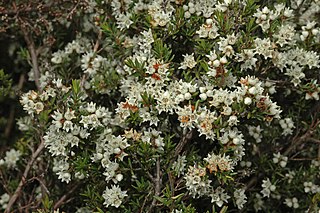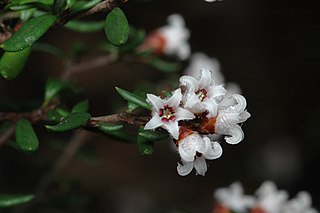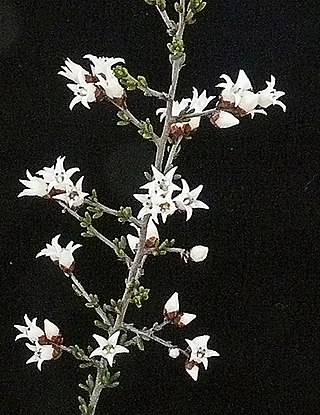
Cryptandra is a genus of flowering plants in the family Rhamnaceae and is endemic to Australia. Most plants in the genus Cryptandra are spiny, heath-like shrubs with small, clustered leaves and flowers crowded at the ends of branches, the flowers are usually small, surrounded by brown bracts, and with tube-shaped hypanthium, the petals hooded over the anthers.

Pomaderris oraria, commonly known as Bassian dogwood, is a species of flowering plant in the family Rhamnaceae and is endemic to south-eastern Australia. It is a compact shrub with hairy branchlets, hairy, elliptic leaves and panicles of hairy, greenish to cream-coloured or crimson-tinged flowers.

Cryptandra tomentosa, commonly known as prickly cryptandra, is a species of flowering plant in the family Rhamnaceae and is endemic to the southern continental Australia. It is a small, straggling, erect to low-lying shrub sometimes with spiny branches, and has cylindrical leaves and loose clusters of white, bell-shaped flowers that turn pink to red as they age.

Cryptandra amara, commonly known as bitter cryptandra or pretty pearlflower, is a species of flowering plant in the family Rhamnaceae and is endemic to eastern Australia. It is a densely-branched shrub with clustered, more or less linear to egg-shaped or elliptic leaves, and tube-shaped white flowers arranged on the ends of branchlets.

Cryptandra ericoides, commonly known as heathy cryptandra, is a species of flowering plant in the family Rhamnaceae and is endemic to south-eastern continental Australia. It is a wiry, low-lying to erect shrub with often clustered, cylindrical leaves, and tube-shaped white flowers arranged in clusters on the ends of branchlets.

Pomaderris phylicifolia, commonly known as narrow-leaf pomaderris, is a species of flowering plant in the family Rhamnaceae and is to south-eastern Australia and New Zealand. It is a slender shrub with hairy stems, narrowly egg-shaped to linear leaves, and small clusters of cream-coloured to yellow flowers.

Cryptandra armata is a flowering plant in the family Rhamnaceae and is endemic to Queensland. It is a shrub with spiny branchlets, spatula-shaped to lance-shaped or egg-shaped leaves with the narrower end towards the base, and creamy-white tube-shaped to bell-shaped flowers.
Cryptandra campanulata is a species of flowering plant in the family Rhamnaceae and is endemic to South Australia. It is a shrub with narrowly elliptic to narrowly egg-shaped or linear leaves and clusters of white, bell-shaped flowers.
Cryptandra ciliata is a species of flowering plant in the family Rhamnaceae and is endemic to south-eastern Queensland. It is a shrub with clustered linear leaves and densely-hairy, white, tube-shaped flowers.

Cryptandra lanosiflora is a species of flowering plant in the family Rhamnaceae and is endemic to eastern Australia. It is a shrub with many branches, linear leaves, and hairy, white tube-shaped flowers.

Cryptandra longistaminea is a species of flowering plant in the family Rhamnaceae and is endemic to eastern Australia. It is a shrub with many branches, egg-shaped or elliptic to linear leaves, and clusters of white, tube-shaped flowers.

Stenanthemum leucophractum, commonly known as rusty poison, white cryptandra or white stenanthemum, is a species of flowering plant in the family Rhamnaceae and is endemic to south-eastern continental Australia. It is a spreading shrub or subshrub with softly-hairy young stems, egg-shaped to fan-shaped leaves and heads of white or yellowish flowers surrounded by white, felt-like floral leaves.

Cryptandra magniflora is a species of flowering plant in the family Rhamnaceae and is endemic to Victoria (Australia). It is a shrub with cylindrical leaves, and clusters of white, tube-shaped flowers.
Cryptandra micrantha is a flowering plant in the family Rhamnaceae and is endemic to the southwest of Western Australia. It is a prostrate or upright shrub with spiny branchlets, narrowly oblong to elliptic leaves and dense clusters of white or cream-coloured, tube-shaped flowers.
Cryptandra minutifolia is a flowering plant in the family Rhamnaceae and is endemic to the south-west of Western Australia. It is a spreading shrub with oblong to elliptic leaves and clusters of white or pink, tube-shaped flowers.
Cryptandra monticola is a flowering plant in the family Rhamnaceae and is endemic to the south-west of Western Australia. It is an erect or spreading shrub with linear or narrowly oblong to elliptic leaves and head-like clusters of white, tube-shaped flowers.

Cryptandra myriantha is a flowering plant in the family Rhamnaceae and is endemic to southern continental Australia. It is a slender, erect or straggling shrub with cylindrical leaves and more or less sessile clusters of creamy-white to pink flowers.
Cryptandra pogonoloba is a species of flowering plant in the family Rhamnaceae and is endemic to south-eastern Queensland. It is a shrub with linear to lance-shaped leaves with the narrower end towards the base, and white to creamy-white, tube-shaped flowers.

Cryptandra propinqua is a species of flowering plant in the family Rhamnaceae and is endemic to south-eastern continental Australia. It is a shrub with many branches, more or less linear leaves, and spike-like clusters of white, tube-shaped flowers.
Cryptandra triplex is a species of flowering plant in the family Rhamnaceae and is endemic to the north of the Northern Territory. It is a hairy shrub with narrowly elliptic to lance-shaped or egg-shaped leaves and white to cream-coloured or yellowish, tube-shaped flowers arranged singly or in groups of up to 5 in leaf axils, near the ends of branches.












